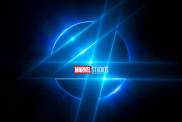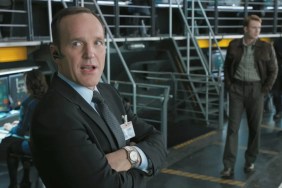
Today, Legendary Comics is debuting their latest new series with Epochalypse, a mind-bending new series from author Jonathan Hennessey, most notable for his non-fiction graphic novels, The United States Constitution: A Graphic Adaptation and The Gettysburg Address: A Graphic Adaptation. Hennessey has partnered up with Superman: Earth One artist Shane Davis for this new series which sees 600 years of human history collapse into a single location with the past, present and future forced to coexist in a dystopian civilization. Inside that city an elite team of “Resynchronization Officers” must rid the world of Anachronisms – futuristic artifacts that threaten the very laws of time. SuperHeroHype had the pleasure of speaking with Hennessey about the project, his inspirations, and what to expect from the future of this rich universe.
SuperHeroHype: To put it bluntly, this series is pretty nuts. So how long has this been cooking in your head? To me it’s so high concept I can’t imagine it’s something that just comes to you one day.
Jonathan Hennessey: Yeah, I have lots of ideas, whether they’re valuable or not who’s to say, but the idea for Epocayalypse is something that has been in one iteration or another, this has been developed by me easily for 15 years, and really actively in its present form since the early 2000s. Just trying to get Epochalypse set up as a comic book was in a weird way what got me into doing the non-fiction histories. I wrote a spec issue of Epochalypse, it was under a different name then, found an artist, which took me many years to find somebody that I could afford and I thought could bring it to fruition. Had this spec issue which I was shopping around and it got close to a deal at a number of places and just wasn’t developed enough, but showed enough potential for someone to say “What other ideas do you have?” which is how I wound up publishing these non-fiction books but Epochalypse really came first but there was a ten year interlude where I was doing these other things.
SHH: Correct me if I’m wrong, but the original title for Epochalypse was “Synchroni-City?”
Hennessey: Yeah, Synchroni-City, which is kind of a mouthful but you can see where that goes. Synchronicity, with a hyphen before “City,” because that alluded to a certain location like the location where they live.

SHH: Is that why the title changed, it was a mouthful as you said or did the content of the actual story spur the change?
Hennessey: No, it wasn’t the content, it was more of a mouthful and there maybe was some legal issues, and actually it was the Legendary people that came up with (it). I was never married to “Synchroni-City,” I liked it enough to keep it while I was developing it but one of the great things Legendary did for me was come up with this other play on words which I think is far superior to the title I came up with, but yeah I was motivated by that.
SHH: Talk about what your inspirations were for this series, because I sense a variety of different things in the ether here.
Hennessey: Right, well the very earliest iteration of the idea came to me I it was actually inspired by architecture. I’m from Boston, I went to school in upstate New York, and I would drive back and forth and stop in Albany, New York from time to time, not necessarily a city known for inspiring very much or being inspirational. There’s a huge place there called the Empire State plaza which was built in the 50s to expand the apparatus of the state government, and it was built by this architect named Wallace K. Harrison who is the guy who designed the UN building in New York, he also had something to do with 30 Rock at Rockefeller Center. When the Empire State was looking to expand, they wanted a real vision for what this place was going to be so they built it and now you go there today and it was made to look futuristic in the ’50s. You go there now and it looks like you’re visiting Tomorrowland in the 60s. It’s not pretty, it’s sort of this paleo-futuristic almost like fascist type architecture, it looks like a little Soviet block in some ways. You go there and the impression that I had was “I feel like I’m in the future that my grandparents imagined” or a future that was supposed to happen and didn’t. It felt like just a place out of time to me. There’s a few other places that are similar. The capital of Brazil was also built in the ’50s to look futuristic and you go there now and it’s all these crazy spiral buildings. There’s a University in Oklahoma, Oral Roberts University, that’s sort of paleo-futuristic too.
That was where it started, it was just nagging me “What was this future that was imagined by an earlier generation that never came to fruition?” Then as I sort of researched more history and fell in love with sort of historical characters and places and lesser known episodes of American history, that’s when I had the “Eureka!” moment and figured out what the concept of Epochalypse was going to be, in a way, turning time travel its head or turning it inside out. In most time travel stories you have one or two people or a group of people going somewhere in time, they have some control over where they go, they go there, they have an adventure, they come back, but in this one nobody is going back. Something makes everybody spontaneously time travel, so basically 600 years of history has collapsed into one timeline. So it’s not people going into history, it’s history disastrously aligning and overlapping with people, ideas, languages, cultures, technologies that were never meant to co-exist, suddenly co-existing.

SHH: Building off of that, given your past work with the non-fiction graphic novels, is it an important factor for you in telling this story to have an accurate portrayal of the past even though it’s set in this alternate place? Or are you trying to have a little more fun with history here?
Hennessey: For me, having fun with history is trying to be as accurate as possible. I love the challenge of trying to represent all these people from so many different timelines and so many different viewpoints and so many different sets of values and cultural ideas. Our main team of heroes, Johanes is very clearly the heroes, but his cohorts are from all over in time and that gives them all very different and, as the series goes on, we’ll see competinig and even dangerous ideas about why they’re there and why they’re trying to do what they’re trying to do.
SHH: On the flip side of that, you’re also playing with people and technology from the future. How do you decide between doing a “Jetsons” version of the future or “The Terminator” version of the future?
Hennessey: Well that’s interesting because as the plot goes on, readers will hopefully get to know, as long as the series gets to keep going on and it’s up to the readers whether it wil or not, that there are going to be multiple representations of the future. There might be an element of the future that the characters are allowed to see and there might be an element of the future that are secretly kept from the characters. In order to start writing it I had to have a vision of the future, because what we have is 600 years of history collapsing into one brand new timeline, and the whole spectrum goes as far as the future of the 2100s. So I had to figure out the characters from this time, where would they be, what would they want, how would they try to co-exist with the people from the past. You and I would count as people from the past in this universe too. We’d be hunted, wanted, “Exotemperals” is the term that I use in the series.
SHH: If I were to describe the first issue I’d say it’s Judge Dredd meets Pleasantville.
Hennessey: [Laughs] I like it, I’m going to write that down.

SHH: Now without spoiling anything, as the series progresses and you’re building more of the world you sort of change things up a little with the second issue. Talk about finding the right tone for this series, because there are a number of ways you could play this.
Hennessey: Could you be a little bit more specific about the tonal? Where you were going with that?
SHH: Well, for example, the Judge Dredd meets Pleasantville comparison, you could go where it’s total comedic tone where it’s wacky or the Judge Dredd route were it’s very serious and no one smiles. Talk about finding the balance of the tone that you have.
Hennessey: Well in the first issue I thought it was important, if we’re setting up this thing of the past, present, and future coinciding, obviously it’s set in this late 1940 or ’50s style diner, which is very easy, nostalgic view of America, and I think the 1950s is sort of the centerpoint of where all this time has collapsed. So what’s really happened is all these things from late 1500s to the 2100s are getting sucked into the year 1951. So 1951 is sort of the center point for it, and there’s a thematic reason for that I hope readers might start to see as the series goes on. But that’s still our cultural reference point for “when things were the best,” it’s the easiest past to conjure up. So I thought for the first issue it was important to get that to make the concept clear enough. It might be less exciting if it was the 1910s or something like that, because there’s not as much people can identify with, but we can all identify with the ’50s. I’ve studied history quite a bit, and there’s a lot of tragedy in history. Tragedy is sort of what steps forward most of the time, just like the news, it’s easier to pick up the bad stories than to pick up the good stories. It’s the devastating stories of the day that get replayed at 10 o’clock. So tonally it was important to me to respect the history, I reserve the right to not respect history possibly with a future project that might happen, but with this the back story to the characters is very important so I thought it was important to respect history and to not be too cute with it.
SHH: Talk about artist Shane Davis’ work on the book and maybe things he came up with might have changed what you originally envisioned, or how that worked out.
Hennessey: I was very fortunate, because I was not somebody with enough sort of influence in the comic book world to get Shane Davis to collaborate with me, that only happens thanks to Legendary. Shane had done some collaborations with him before and they were interested in continuing to work with him because they’re trying to set up like Image or anybody else who is trying to be #3 or even replace Marvel or DC. There’s a lot of competition out there. They felt that Shane was one of the best that represented their vision. Shane had free hand to pick among the projects that Legendary was interested in doing and I think he read a synopsis of mine and it happened to speak to him, so I feel very lucky. He’s done an absolutely bang up jump with it. I didn’t have the pleasure of working with him closely, because he’s in New Jersey, but he’s a marquee name in comics, which I am not, and he deserved to have a free hand, had a free hand, and worked great with it.

SHH: How many different looks for the Resynchronization Officers did you guys come up with before settling on a design?
Hennessey: I don’t think there were too many. He came up with it very quickly. Like I mentioned, this was a project I’ve been developing for a long time and early on to get it out there I had independently produced a spec issue with another artist just to shop it around and show people, but it’s interesting there is a little bit of an overlap between how the Resyncronizers looked with the artist and how they look with this. I don’t know what to attribute that other than kismet and good luck.
SHH: This is certainly the kind of rich world with an endless potential for stories. Talk about narrowing the focus down to the story you wanted to tell.
Hennessey: The main character is from the 1640s and he’s actually a Dutch colonist who came over to New Amsterdam from the old world, so this is someone who is coming along very early in American history with a real innocence about what’s going to happen after the 1640s. He’s very much an outsider of history because he comes into this universe early into that spectrum from where history has collapsed. I like that, because it’s an interesting historical exercise to put somebody in who is sort of so innocent and almost naïve and doesn’t have a set of values that even people from a hundred years later, two hundred years later in the same country have. The history of Dutch New York is not something people know about it, but it’s not the most familiar episode of history out there. So Johanes and his other cohorts come from different places from history, one character is from the 1820s, one is from the 1930s – there’s a few other Resynchronizers we’ll meet that are all from before the 1950s. As the series goes on, we’ll learn a little more about their backstories and the very specific and different and challenging and sometimes dangerous ways that we’ll find they relate to the present and the future in their mission to restore history.
SHH: I’m curious what the length plan is for Epochalypse, is it something you’ve got mapped out for a little while? Or is it something you want to do for twelve issues? Or is it something you want to do as an ongoing?
Hennessey: Any of us who are fanboys have seen things start with great ideas that may have a lot of potential if they’re fulfilled and then sort of end with a whimper. My envision is to not repeat, for example the TV series “LOST” is the first thing a lot of people talk about like, “Ugh, this was so interesting and it raised so many questions and it was so intriguing but uhh where did it end?” So I specifically have a cycle, a hard end where all the answers will be provided for how this world got to be the way it is, all the questions will be answered. I would like to see it as a longer maxi-series, but I think it is a very rich universe, it could be spun off and continued to be explored, but there’s definitely a vision for one strong cycle that will be brought to a hopefully satisfying ending.
Epochalypse #1 is available in stores today.








